Study Shows That Smithsonian Curriculum and Professional Development Improves Science, Reading and Math in Elementary Classrooms

Educators from North Carolina and South Carolina test the Smithsonian Science for the Classroom curriculum during a professional development training at the Smithsonian Science Education Center.
A newly released independent study conducted over a five-year period offers evidence of the impact of the Smithsonian Science for the Classroom high-quality curriculum paired with professional learning on elementary school student achievement in science, math and reading. Conducted against the backdrop of the COVID-19 pandemic, the study’s results are particularly relevant to ongoing recovery efforts aimed at combating learning loss and teacher burnout.
As part of this research collaboration with the Smithsonian Science Education Center, the Center for Research in Educational Policy (CREP) at the University of Memphis conducted a school-level randomized controlled trial following a cohort of more than 1,600 students, grades three through five, in North Carolina and South Carolina. Predominantly rural schools were assigned to implement either the Smithsonian Science for the Classroom curriculum with supporting professional learning (treatment group) or continue teaching business-as-usual (control group). CREP then assessed the cumulative impact of the Smithsonian Science Education Center’s resources over three school years on the students relative to their comparison group peers. Using a mixed-methods approach, CREP sought to discover whether the Smithsonian’s intervention improves student achievement, particularly that of high needs students, in science, math and reading.
Highlights of the evaluation of Smithsonian Science for the Classroom curriculum with accompanying professional learning include:
- For the combined sample, students showed statistically significant gains in science on the Stanford Achievement Test (SAT10) relative to the business-as-usual group.
- When their SAT10 scores were separated out, students for the combined sample identified as belonging to groups that are traditionally underrepresented in science, technology, engineering and math (STEM) fields—females, the economically disadvantaged, those with individualized education programs (IEPs) and those who are Black, Indigenous and people of color (BIPOC)—still outperformed their peers in science; the difference for females was statistically significant.
- For the combined samples across both states, students performed better in reading and math on their state assessments than their peers who received business-as-usual science instruction.
“It is not always easy for elementary teachers to find time to teach science,” said Carol O’Donnell, the Douglas M. Lapp and Anne B. Keiser Director of the Smithsonian Science Education Center. “But with these data, we now know that teachers in elementary school can take time to teach science and improve students’ science knowledge, as well as improve their reading and math achievement. This study shows that highly-quality instructional materials that are driven by natural phenomenon and real-world problems, along with aligned and differentiated high-quality professional development, are essential to early learning. We appreciate the expertise of CREP, the education organizations in North Carolina and South Carolina with whom we collaborated and the teachers who participated in this study and dedicate their lives to the most important profession of our time—teaching. This research has laid the groundwork for years to come as we continue to bring the Smithsonian into classrooms across the U.S.”
The contents of this report were developed under an early-phase Education Innovation and Research (EIR) grant (PR# U411C190055) awarded to the Smithsonian Science Education Center from the U.S. Department of Education.*
*The contents of the report do not necessarily represent the policy of the U.S. Department of Education, and readers should not assume endorsement by the federal government.
About the Smithsonian Science Education Center
The Smithsonian Science Education Center (SSEC) is transforming K–12 Education Through Science in collaboration with communities across the globe. The SSEC is nationally and internationally recognized for the quality of its programs and its impact on K–12 science education. Visit the SSEC website to learn more about the Smithsonian Science for the Classroom curriculum and the Smithsonian Science for North and South Carolina Classrooms project. Follow SSEC on LinkedIn, X and Facebook.
# # #
SI-350-2024
